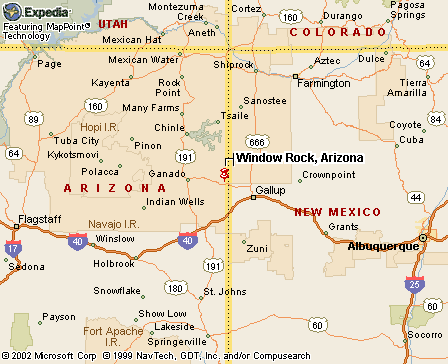|
|
Canku Ota |
|
|
(Many Paths) |
||
|
An Online Newsletter Celebrating Native America |
||
|
July 28, 2001 - Issue 41 |
||
|
|
||
|
Tribe Salutes 'Rising Star' |
||
|
by Larry Di Giovanni Gallup Independent Staff Writer-July 18, 2001 |
 WINDOW ROCK
— Folks who are as proud of U.S. Army Maj. Tracey Clyde as his own family are Navajo Nation Council delegates.
They spent about a half-hour during Tuesday's council session congratulating Clyde and saluting his military accomplishments. WINDOW ROCK
— Folks who are as proud of U.S. Army Maj. Tracey Clyde as his own family are Navajo Nation Council delegates.
They spent about a half-hour during Tuesday's council session congratulating Clyde and saluting his military accomplishments.
"He (Tracey) is only three ranks away from becoming a general in the U.S. Army," said proud brother Victor Clyde, a tribal prosecutor from Chinle. About a dozen of Tracey Clyde's family members came to tribal Council Chambers to see the council pass a resolution praising his promotions. Victor Clyde knows the Army's ascending ranks major, lieutenant colonel, colonel, then general and discusses them with his high-achieving brother. "That's the kind of encouragement we give him," Victor said. "I'll keep going as long as they keep promoting me," said Tracey Clyde, 34, who was a difficult interview as every minute or two, a tribal delegate or employee would approach to offer a hand shake. Clyde was promoted from captain to major on Dec. 1, 2000, in Norfolk, Va. The U.S. Army has had at least one Native American general in its history, but to Clyde's knowledge none who has been Navajo. Born and raised in Shiprock and a 1985 Shiprock High School graduate, Clyde graduated from the Army's West Point Academy in 1989. Clyde works out of the Pentagon's Army Watch Program in Washington. Its staff keeps the Army's chief of staff informed as to all Army operations. Speaking before the council, Clyde praised the tribe's educational system and its teachers. He attended Head Start in Crystal, and spent much of his youth in Sweetwater, Ariz., where he helped his grandfather herd sheep. "That helped prepare me for all of the foot marches you have to do in the Army," he said. During Operation Desert Storm, Clyde remained in the states, an artillery platoon leader in Fort Sill, Okla. His platoon was in charge of keeping watch over a Lance nuclear missile. Tracy's mother, Stella Clyde, lives in Shiprock. A second brother, Virgil Clyde, is from Gallup. Sisters Sylvia and Josephine also attended Tuesday's council recognition, as did an aunt, Alice Norton, and several nieces and nephews. Clyde's father is the late Joe Clyde of Sweetwater. Clyde's wife, Shelly, an Army captain, was unable to attend. Clyde's resolution sponsor was Delegate Robert Whitehorse (Aneth/Red Mesa/Mexican Water chapters). Clyde received a blanket with the Navajo seal, and handed out U.S. Army-insignia portfolio bags and a gym bag to Whitehorse and other delegates who recognized him. |
|
|

